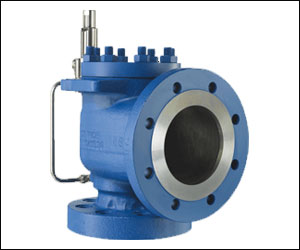Pilot operated safety relief valve
 Like other pressure relief valves (PRV), pilot operated relief valves (PORV) are used for emergency relief during overpressure events (e.g., a tank gets too hot and the expanding fluid increases the pressure to dangerous levels). The difference between PORV and conventional PRV is that pilot valves use system pressure to seal the valve. A PRV typically uses a spring to hold the disc or piston on seat. The essential parts of a PORV are a pilot valve (or control pilot), a main valve, a pilot tube, the dome, a disc or piston, and a seat. The volume above the piston is called the dome.
Like other pressure relief valves (PRV), pilot operated relief valves (PORV) are used for emergency relief during overpressure events (e.g., a tank gets too hot and the expanding fluid increases the pressure to dangerous levels). The difference between PORV and conventional PRV is that pilot valves use system pressure to seal the valve. A PRV typically uses a spring to hold the disc or piston on seat. The essential parts of a PORV are a pilot valve (or control pilot), a main valve, a pilot tube, the dome, a disc or piston, and a seat. The volume above the piston is called the dome.
PORV are also called pilot-operated safety valve (POSV), pilot-operated pressure relief valve (POPRV), or pilot-operated safety relief valve (POSRV), depending on the manufacturer and the application. Technically POPRV is the most generic term, but PORV is often used generically (as in this article) even though it should refer to valves in liquid service.
Comparison to non piloted pressure relief valves
Advantages
* Smaller package on the larger pipe sizes.
* More options for control.
* Seals more tightly as the system pressure approaches but does not reach set pressure.
* Control pilot can be mounted remotely.
* Some designs allow for changes in orifice size within the main valve.
* can be used in engines
Disadvantages
* More complex, resulting in various fail-open failure modes.
* More expensive at smaller sizes (starts to even out as pipe size increases).
* Small parts in pilot valve are sensitive to contaminant particles.



